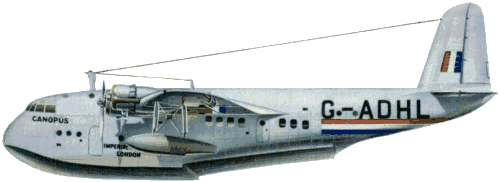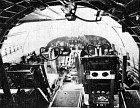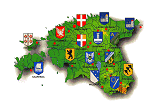Aircraft Profile #84. Short Empire Boats |
|
|
When, in 1935, it was announced that Imperial Airways had placed an order for twenty-eight flying boats of a new type that had not yet been designed, yet alone flown, and that these new boats would weigh eighteen tons apiece, the act was hailed as one of the world's boldest experiments in aviation. But there were others, however, who referred to the order as a gamble. The reason for Imperial Airways' hurry was not difficult to see. World-wide air travel was booming and the company was anxious to get more than its fair share of future business for Britain. Major R. H. Mayo, Imperial Airways' Technical Adviser, had been collecting statistics for some time and from this research had built up a specification for an aircraft which could be used for passengers and freight throughout the world. It would carry twenty-four passengers in spacious comfort and still have ample room for air mail or freight; cruising speed would be 258km/h and normal range 1125km - although there would have to be room to stretch this to some 3220km to serve the North Atlantic route which the company hoped to open later. Because the flying boat was in vogue and because it was thought impossible to build a landplane of this size and weight with acceptable landing and take-off characteristics, a flying boat was required. It was obvious that the order should go to Short
The man responsible to Short for the design of the Empire Boat was Arthur Gouge and his starling point was the cubic capacity which Imperial Airways had specified for each passenger. Preliminary calculations indicated an aircraft with the wing carried on a hump above the fuselage to provide the necessary clearance between propeller tip and water but it was then decided that there would be less drag if the fuselage depth could be increased up to the wing. This gave more volume than required but enabled the cantilever wing to be fitted into the fuselage in a manner that was both lighter and stronger than that possible with a hump. Up to this time Short flying boats had been built with wide planing bottoms but, with a boat weighing eighteen tons, excessive water drag would inhibit takeoff performance. Gouge therefore set
As another aid to take-off and landing Gouge designed into the aircraft flaps patented by himself. The Gouge flaps fitted to the Empire Boats were designed to increase wing area with little or no increase in drag and without destroying the flow over the top of the aerofoil. Calculations, later borne out in operation, showed that the lift coefficient of the wing could be increased by 30% to reduce landing speed by 19km/h without any change in trim. The basic aerodynamic design was built around the Short Scion Senior which virtually served as a half-scale prototype for the Empire Boats. This development of the twin-engined Scion was a high cantilever wing cabin monoplane powered by four Pobjoy Niagara engines of 90hp each. First flown in 1935, it was built in both landplane and floatplane versions, had a span of 16.76m., a length of 12.80m and a wing area of 37.16m². As a floatplane it had a maximum speed of 215km/h and cruised at 195km/h at 3,200 r.p.m. or 185km/h at 3,100 r.p.m. All-up-weight was 2608kg. The final design of the S.23 Class Empire Boat showed its obvious relationship with the Scion Senior. The Empire Boat was a clean-looking high-wing monoplane
No machine of this size and complexity had been built before by the British aircraft industry and Shorts found many problems in construction which could only be overcome by developing new techniques. The mainplane spar booms, for instance, were machined from lengths of "T"-shaped Reynold's extrusions in Hiduminium R.R.56 alloy. These came in lengths of 6.71m only and had to be joined end to end to make up one half spar boom. These sections then had to be machined to a constant taper from root to tip to an accuracy of within 0.01cm, and there was no machine on the market capable of performing this task. Shorts accordingly built their own. The wings were covered with flush-riveted Alclad and had Frise-type ailerons. The Gouge flaps were worked by screw jacks driven by a 0.5hp Rota electric motor running at 6,000 r.p.m. geared down to turn the jacks at 500 r.p.m. and which lowered the flaps in 60 seconds and raised them in 90. The size of the wings made accommodation of fuel tanks simple and the normal medium-range
Sections of the wing leading edge on each side of the four nacelles folded down to serve as servicing platforms for the engines and the floats, which were carried on a pair of struts in tandem attached to the main spar, had a shock absorber carried between the bracing wires which allowed them to move backwards some four inches and thus prevent undue torsional loads being transmitted to the wing if sudden waves were struck at speed. Although the hull was radically new in shape its construction generally followed the practices evolved in previous Short boats and stringers were interrupted at formers instead of being notched to run continuously. The Empire Boats had stringers of "Z" section which were attached to the formers by plain angle brackets. The keel was built up on an "I" section girder and, with the two chines (the angle where the fuselage sides meet the planing bottom) formed a triangular section. Earlier Short boats such as the Kent Class and the Calcutta had been characterised by a sudden reduction in beam above the chines, the sides of the fuselage being faired into the chines by a planking of double or “S" curvature - a difficult form of construction involving considerable panel beating. In order to simplify construction
The 5.18m deep hull made it possible to provide accommodation on two decks. The pilot and co-pilot sat in a spacious cockpit dignified with the word "bridge", with the radio operator facing rearwards behind the captain. Aft of this on the upper deck was a long compartment divided longitudinally to provide space for 1360kg of freight und mail on the port side und the ship's clerk's office to starboard. The clerk had charge of a panel containing fuses and switches for all circuits and lighting inside the boat. He also had access to handles controlling the opening of the annular skirts of the cooling flaps for the four engines, fuel cocks and ventilation air intake controls. A step-ladder at the aft end of the clerk's office led to the galley in the lower deck. Behind the clerk's office, but not directly accessible from it was a storage space for bedding and other sundries. A spacious marine compartment was located at the forward end of the lower deck and this carried an anchor, two drogues, a retractable mooring bollard and a boat hook. A retractable Harley lamp was mounted on a hinged panel off-set to port. Direct communication between the "bridge" and mooring compartment was by
The flight deck was, for its day, very well equipped. Rudder, elevator trim and the flap-operating switch were carried above the windscreen between the two pilots. Engine starter switches were placed at the top of the central coaming and below this were the engine switches and auto-pilot panel. The throttle quadrant was normal but carried on each side two large "cut out levers". Large boats were often called on to do much taxiing after a flight and engines tended to overheat and continue firing after being switched off. The "cut out
The flying instruments included a Hughes turn indicator, Sperry artificial horizon and directional gyro, a Kollsman sensitive altimeter, a liquid pitch indicator, a Hughes rate-of-climb indicator, a Marconi homing indicator and a special Smith's chronometer. Both pilots also had a Hughes P/4/11 compass. The radio officer sitting behind the captain had Marconi sets for receiving and transmitting on 600-2,000 metres and in the 16-75-metre band. The sets were mounted in shock-proof supports and incorporated the direction-finding receiver. The loop for this was on a retractable mounting which had provision for turning the assembly athwartships so that it could be used for visual or aural homing. The nine-cylinder, radial, air-cooled Pegasus Xc engines were the commercial version of the Pegasus X and were rated at 740hp at 1066m, 910hp was available for take-off with the de Havilland v.p. propeller permitting the engine to turn at 2,475 r.p.m. Normal cruising output was 510hp. The 28.7-litre engine weighed 458kg, and measured 1.40m in diameter. Rotax-Eclipse direct-cranking starters with hand-turning gear operated from 12 volts and turned the engines at some 25-30 r.p.m. Canopus, the first of the Empire Boats, made her maiden flight on 4th July 1936,
Performance figures proved by test flights showed a maximum speed of 320km/h at 1680m, a maximum cruising speed of 265km/h using 510hp per engine and a minimum flying speed of 118km/h. Rate of climb at sea level using coarse pitch was 290m/min, absolute ceiling was 6100m and normal still air range, 1225km. Take-off time at maximum all-up-weight was twenty-one seconds. The first flight on behalf of Imperial Airways was made on 17th September by Squadron Leader (later Air Commodore) H. G. Brackley, I.A.’s Air Superintendent, and the final proving and delivery flight to Marseilles for use on the Mediterranean route was made on Thursday, 22nd October. Bad weather delayed the boat's arrival at Marseilles until 25th October. Caledonia, the second Empire Boat, had made her maiden flight on 15th September and was delivered to Imperial Airways on 4th December 1936. She was the first of the long-range boats and had three fuel tanks in each wing containing 1727 l, 1477 l, and 795 l, each, plus another two tanks each
From September the Empire Boats were completed at a rate of rather more than one per month and delivery dates were never more than a few days after the first Right sometimes an aircraft was handed over to Imperial Airways immediately after its first flight. Coorong, the last of the initial order of twenty-eight aircraft was delivered on 26th February 1938 and this boat, together with Coogee and Corio which preceded it on the production line, were taken out of the Imperial Airways order and delivered to Qantas Empire Airways. These S.23 boats served their purpose admirably. They were seldom out of the news and rapidly built-up what must still rank as one of the most highly-developed air networks linking England with Africa, India and Australia. True enough there were crashes, Cygnus, Capricornus, Courtier and Calpurnia had been written off by the end of 1938, but in no case could the blame be placed on a fault inherent in the boats concerned. The honour of making the first regular flight in a "C" Class boat fell to Captain H. W. C. Alger in Castor. The journey should have started on 6th February 1937 and the boat did, in fact, take off promptly at 11:45 a.m. from Hythe carrying eight passengers and more than a ton of freight and mail, including
Ten days later the long-range boat Caledonia, flown by Captains W. N. Cumming and A. S. Wilcockson flew the 3700km between Calshot and Alexandria non-stop at an average speed of 274km/h. On 21st February Captain J. G. Powell took Cambria, another long-range boat, on a circuit of Britain (light covering 2090km non-stop in 8 hr. 42 min., an average speed of 217km/h. The greatest achievement of 1937 was, however, the first Atlantic crossing by an Empire Boat which was made by Caledonia on 5th July with Captain Wilcockson at the controls. Flying a rhumb-line course Caledonia covered the 3207km between Shannon and Botwood in 15 hr. 3 min. A Sikorsky Clipper III made the reverse crossing simultaneously on the slightly shorter great circle course and her time was 12 hr. 34 min. Caledonia was, however, to regain the honour for Britain. Simultaneous return crossings were made on 22nd July and Caledonia's time for the West-Rust journey was 12 hr. 7 min. against the Clipper III's 16 hr. 24 min. for the East-West crossing. After all allowances for wind differences and other variables, the Empire Boat was fastest overall. Proof that Imperial Airways thought their original conception
Champion was the first S.30 boat to be laid down but Cabot, the aircraft
One other S.30 boat was ordered during 1939 and G-AFKZ Cathay was delivered to Imperial Airways during its last days in March 1940. Another three boats ordered by I.A. in 1939 were built to the same basic construction as the others but were powered by Pegasus XI engines and cleared only up to 18370kg all-up-weight. They were, therefore, virtually the same as the original S.23 boats but were built as the S.33 Class. Only two boats were completed and Clifton and Cleopatra, as they were named, were delivered direct to BOAC. PICK-A-BACK EXPERIMENT No mention of the Empire Boats would be complete without including what is still one of the most remarkable aerial experiments of all time. Major R. H. Mayo, who had played no small
Mercury, the upper component, was a four-engined, high-wing monoplane which also had an obvious affinity with the Scion Senior. Power was provided by Napier Rapier V engines each developing a maximum of 340hp at 3960m. Span was 22.25m and all-up-weight 5670kg when flying alone but increasing to 9300kg when air-launched from Maia. These weights were later increascd to 6350kg and 9435kg respectively when the engines were changed to Rapier VIs developing a maximum of 395hp. Tests of the two aircraft continued individually during the latter part of 1937 with Lankester Parker being responsible for Maia and Harold Piper, another Shorts' test pilot, flying Mercury. Neither aircraft displayed any alarming symptoms although there was trouble with the telephone communication between the two aircraft when they were coupled and this was to lead to a slight delay in the crucial test for combined flying and release. All eight engines were used during combined flight but the controls of Mercury were locked. The aerofoil designs of the two aircraft were such that Mercury's wings were carrying the major part of the air load at the speed and height chosen for separation. Safety locks prevented separation until this speed and height were reached and both pilots had an unlocking handle, both of which had to be pulled to
The first attempt on the Atlantic came on 21st July 1938. Captain Wilcockson was at the controls of Maia and Captain D. C. T. Bennett, later of Pathfinder fame, piloted Mercury when the composite took off from Foynes on the west coast of Ireland. Mercury, which carried 272kg of freight and mail, arrived at Boucherville, Montreal, 20 hr. 20 min. later, having flown the 4602-km course at an average ground speed of 227km/h. Average air speed was 285km/h. Later that year, on 6th October, the same technique was used for Mercury, again flown by Bennett, to fly from Dundee, Scotland, to Orange River, South Africa, a distance of 9730km, in 42 hr. 5 min. So successful were the experiments with this pair that there was little doubt that they would have continued with landplane versions, but the war intervened. The scheme was to be resurrected, however, when a means was sought to provide aerial protection for Atlantic convoys. A Liberator/Hurricane composite was proposed and work was well-advanced at Hawkers but discontinued when
BIGGER STILL There was to be one other development of the Empire Boats and that was the S.26 or "G" Class. Three of these were ordered by Imperial Airways. Basically similar to the "C" Class but bigger in every way, they were designed to an all-up-weight of 33340kg, had a span of 40.94m, and were powered by four Bristol Hercules IV engines. Maximum speed was 336km/h and cruising speed 282km/h at 1524m. Outwardly they looked like normal "C"-Cass boats but had a Sunderland-type planing bottom with its sharp, V-shaped step at the aft end, and a cleaner sweep to the lines at the forward end of the fuselage. Imperial Airways planned to use these boats on the North Atlantic route but war intervened. Golden Hind was the first of these boats and the other two were originally named Grenadier and Grenville, but these were re-christened before launching as Golden Fleece and Golden Horn. All three were impressed into R.A.F. service and titled with turrets before being used as V.I.P. transports. Neither Golden Fleece nor Golden Horn survived the war but Golden Hind soldiered on and was probably the longest lived of the Empire Boats. After the war she was used on routes to Australia and Africa by the Ministry of Aviation and sold to BOAC in 1948 when her Certificate of Airworthiness expired. The airline seemed in
Many other Empire Boats played their part in the war, mainly as transports with BOAC or QEA. Two of them were returned to Short Brothers and Harland at Belfast at the beginning of 1941 and modified to incorporate gun turrets and an array of ASV aerials on the top and sides of the fuselage. Clio arrived at Belfast having flown 4,382 hr. 55 min. in her civilian role and was re-launched on 12th March 1941 as AX659. Cordelia flew 4,261 hours with airlines and became AX660 when she was re-launched at Belfast on 16th April. Unfortunately for the flying boat the war turned virtually the entire British aircraft industry towards landplane development and by 1945 the flying boat had been left behind in performance. Nevertheless, the Sandringhams and Hythes which provided flying boat services with BOAC and other airlines in the years immediately following the war owed their design directly to the Empire Boats and, in fact, their influence can be seen in every flying boat built since. This is no mean achievement for an aircraft which was designed, built and in service within eighteen months of an order being placed. Geoffrey Norris, 1966 |
 All the World's Rotorcraft
|


















